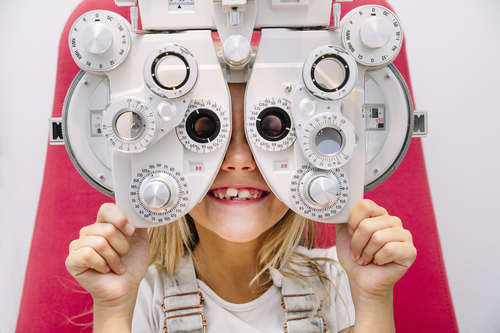Why Picking an Eye Doctor Optometrist is Vital for Your Eyes
Why Picking an Eye Doctor Optometrist is Vital for Your Eyes
Blog Article
Checking Out the most up to date Technological Advancements in Optometry and What They Mean for Eye Doctors
In the ever-evolving area of optometry, recent technical advancements are reshaping just how experts come close to eye treatment. From the accuracy of Optical Coherence Tomography to the nuanced insights offered by AI-driven analysis tools, these developments are setting brand-new standards in person assessment and treatment. Teleoptometry is positioned to redefine availability, guaranteeing that proficiency goes beyond geographical limitations. As these improvements permeate the technique, optometrists are encountered with the challenge of welcoming these tools to boost client results. The question stays: just how will these technological shifts redefine the functions and duties within the profession?
Innovations in Diagnostic Equipment
Progressing the area of optometry, advancements in diagnostic tools have changed the way eye care professionals evaluate and identify ocular conditions and aesthetic problems. The previous years has actually experienced significant technological developments, making it possible for more accurate and extensive analyses. Optical Comprehensibility Tomography (OCT), for instance, gives high-resolution cross-sectional photos of the retina, permitting the very early discovery of conditions such as glaucoma and age-related macular degeneration. This non-invasive imaging strategy has actually come to be important in contemporary optometric practice.
An additional trick advancement is the intro of innovative corneal topography systems, which map the surface curvature of the cornea with accuracy. These devices are especially valuable for suitable get in touch with lenses and identifying corneal problems. Digital retinal imaging has transformed traditional ophthalmoscopy, providing in-depth, breathtaking sights of the retina that help with thorough visual exams.
The development of wavefront aberrometry has likewise been critical, enabling the analysis of refractive errors with unequaled precision (Optometrist Chino). This technology helps in personalizing rehabilitative lenses and boosting medical outcomes for refractive surgeries. Collectively, these analysis improvements encourage eye doctors to provide superior client care, guaranteeing early intervention and customized treatment techniques, eventually boosting aesthetic wellness outcomes
AI in Individual Administration
Building on the structure of advanced analysis tools, the unification of fabricated knowledge (AI) in patient management represents a transformative leap for optometry. AI systems are significantly utilized to boost performance, precision, and customization in person treatment.
Additionally, AI-driven platforms assist in structured client communications and administrative procedures. Automated organizing, online consultations, and individualized follow-up strategies not just enhance patient contentment but additionally optimize time administration for practitioners. These systems can triage clients based on the necessity of their conditions, making sure that those in vital requirement get punctual attention.
Furthermore, AI boosts decision-making by providing optometrists with evidence-based suggestions and therapy pathways. By integrating data from digital wellness records, AI tools use understandings that notify medical choices, minimizing the threat of mistakes and boosting patient results. As AI remains to advance, its duty in patient management will likely increase, reshaping the landscape of optometric care.
Developments in Retinal Imaging
In the world of optometry, retinal imaging has observed impressive technical advancements that are boosting diagnostic capabilities and patient care. Developments such as Optical Comprehensibility Tomography (OCT) and fundus digital photography have actually changed how optometrists visualize and evaluate the retina. OCT, particularly, gives content high-resolution, cross-sectional pictures of the retina, permitting the in-depth evaluation of its layers. This capability is invaluable for early detection and monitoring of problems like glaucoma, diabetic retinopathy, and age-related macular degeneration.
Boosted imaging modalities like OCT angiography are further refining analysis precision. Optometrist Chino. Such improvements promote the recognition of min retinal changes that might signify condition progression.
In addition, advancements in man-made intelligence are increasing retinal imaging by making it possible for automated analysis of huge datasets. These systems aid optometrists in identifying patterns a measure of pathology, thereby improving analysis accuracy and performance. Jointly, these developments are changing retinal imaging into a cornerstone of modern-day eye treatment, boosting results and increasing healing possibilities.
Teleoptometry's Growing Duty
Teleoptometry is significantly becoming an essential part of eye care, driven by advancements in digital interaction and diagnostic devices. This is specifically valuable in rural and underserved areas where access to specialized eye treatment is commonly restricted.
The integration of synthetic intelligence (AI) further boosts teleoptometry, allowing the analysis of aesthetic data and assisting in the detection of eye problems such as glaucoma and diabetic retinopathy. AI-powered formulas can quickly interpret complicated imaging data, giving optometrists with beneficial insights that bolster professional decision-making.
Additionally, teleoptometry sustains continuity of care through seamless assimilation with electronic health records (EHRs), enabling eye doctors to maintain detailed individual histories. This ensures that individuals get regular and personalized treatment also when speaking with different professionals.
Regardless of these benefits, challenges continue to be, including making sure information safety and security and taking care of individual expectations. Nonetheless, teleoptometry stands for a considerable stride in the direction of more available, effective, and patient-centered eye treatment. As technology evolves, its function is poised to expand additionally.

Future Fads in Eye Treatment
A myriad of cutting-edge trends is set to improve the future of eye care, driven by technical innovations and the progressing demands of individuals. One substantial fad is the assimilation of expert system (AI) in diagnostics, which guarantees to boost the accuracy and effectiveness of eye assessments. AI formulas can evaluate vast amounts of data from retinal images, potentially discovering problems like blog diabetic retinopathy and glaucoma earlier than conventional techniques.
Moreover, customized medicine is getting traction in optometry, with genetic screening notifying customized therapy strategies. This method intends to maximize client end results by customizing interventions to individual genetic profiles. Wearable technology, such as clever call lenses, is additionally on the horizon, providing real-time tracking of intraocular stress or glucose degrees, therefore supplying constant insights into eye and systemic health.
The fostering of enhanced reality (AR) and online fact (VR) in training and person education is an additional arising trend. These modern technologies supply immersive experiences that can boost understanding and skills both for optometrists and individuals. As these patterns evolve, eye doctors must remain abreast of technical advancements to supply advanced treatment, ensuring enhanced individual outcomes and contentment in the dynamic landscape of eye treatment.
Verdict

Jointly, these diagnostic improvements equip eye doctors to deliver exceptional patient treatment, ensuring very early intervention and tailored therapy methods, eventually improving aesthetic health and wellness outcomes.

As these innovations Go Here continue to advance, eye doctors need to adjust and include them into method, eventually maximizing process efficiency and elevating the criterion of eye care provided to patients.
Report this page